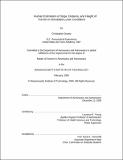Human estimation of slope, distance, and height of terrain in simulated lunar conditions
Author(s)
Oravetz, Christopher
DownloadFull printable version (15.26Mb)
Other Contributors
Massachusetts Institute of Technology. Dept. of Aeronautics and Astronautics.
Advisor
Laurence R. Young.
Terms of use
Metadata
Show full item recordAbstract
As NASA's Vision for Space Exploration seeks to explore mountainous regions near the southern pole through frequent, long excursions, astronauts will require accurate navigational assistance. Current and future technology, including LIDAR data, laser rangefinders, and path planning programs will likely be available; however, the human's own perception of the terrain may affect their confidence in these instruments and be necessary during emergency situations. These unique lunar conditions are expected to affect human perception: the lack of an atmosphere (inhibiting the use of aerial perspective as a distance cue and causing the formation of deep cast shadows), the non-Lambertian regolith reflectance properties, the lack of familiar objects, and the physiological effects of reduced gravity. This project examines the inherent errors humans make when judging the slope, distance, and height of terrain, both on the Earth in a lunar-like environment and on the Moon using photographs from the Apollo missions. Five experiments were conducted in field and Virtual Reality (VR) environments. The effects of true slope, true distance, and sun elevation on slope estimates were determined using visual and motor responses in a lunar-like Utah environment and reproduced in a VR environment using synoptically viewed images in two body positions, under normal and lunar Gz loading conditions. The effects of true slope, distance, and body position on slope, distance, and height estimates of synoptically viewed Apollo panoramic images were measured and compared to measurements obtained from topographical maps. Systematic and random errors were determined for all estimates. Slope estimate comparisons were made between lunar-like and lunar terrain and also between lunar hills and craters. Slope was significantly overestimated in the field study by 130 - 230 with large between-subject errors. (cont.) Lunar-like field and VR slope estimates were not significantly different from each other. Slope estimates were significantly greater at lower sun elevations and closer distances in the Lunar-like VR Study. Both slope and distance estimates were significantly greater from a lunar Gz supine position. Lunar distance estimates varied largely and slope estimation errors were significantly greater for craters than for hills. A new relationsihp between hill shape and perceived steepness was also discovered. The recommendations of this study include the development of a VR training tool to calibrate an astronaut's slope, distance, and height perception prior to lunar missions and future field studies at Devon Island to determine the effect of hill shape on estimates and to determine the regression coefficients of sun elevation and distance variables to be used in a model integrated with rangefinding devices in a Heads-Up-Display (HUD).
Description
Thesis (S.M.)--Massachusetts Institute of Technology, Dept. of Aeronautics and Astronautics, 2009. Includes bibliographical references (p. 161-166).
Date issued
2009Department
Massachusetts Institute of Technology. Department of Aeronautics and AstronauticsPublisher
Massachusetts Institute of Technology
Keywords
Aeronautics and Astronautics.